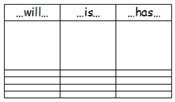User login
Description:
The child will make sentences in the past, present and future, with reducing amounts of support.
| Early years skill: | not specified |
| Early years typical range: | not specified |
| P-scales/Curriculum skill: | English Speaking |
| P-scales/Curriculum level: | P8 |
| TAP skill: | Expressive Language |
| TAP level: | TAP48 |
| Pre/Nat. Curriculum Area: | not specified |
| Pre/Nat. Curiculum Standard: | not specified |
| Phoenix Area: | not specified |
| Phoenix Step: | not specified |
| Section: | Primary (5-11yrs) info |
| Activity/strategy name and materials required | How to do the activity | Key principles for doing the activity and comments |
|---|---|---|
| Sequencing pictures sheet Sheet with boxes labelled "...will...", "...is..." and "...has...":
Simple sequencing pictures showing an action that is about to happen, the same action happening and the action when it is complete, for example Black Sheep Press's 3-step sequencing pack. Alternatively, you could make your own (e.g. take photos of the child, or draw them) or you could print them out from a picture resource such as "Flash-Pro" if you have it, or use other commercially produced sequencing pictures such as LDA or Colorcards. Glue or Blu-tac Pen or pencil | 1. Put the sheet with the boxes labelled "....will....", "....is...." and "....has...." in front of the child and help the child to read the words. 2. Mix up the pictures from one of the sequences. 3. Help the child put them in the correct order, putting them in the correct boxes on the sheet. 4. Ask him/her to describe the sequence, using the words "will", "is" and "has" in his/her description (e.g. "the boy will eat the apple, the boy is eating the apple, the boy has eaten the apple"). You may need to give the child some support to use the right form of the verb at this stage. 5. Help him/her to stick them in the correct places on the sheet (use Blu-tac if you want to be able to re-use the pictures). 6. Help the child to write a description (using the words "will", "is" and "has") under the pictures. | Make sure the child does not glue anything on to the sheet until you (and they) are confident the pictures are in the correct order. If the child cannot write, they could dictate their description to you, and you could write it under the correct picture. In some cases it will feel more natural to use "going to" than "will" (for example, "The boy is going to eat the apple" rather than "The boy will eat the apple"), you should always use (and encourage) the form which feels the most natural. |
| "Matching threes" game Sequencing pictures as above. | This activity could be carried out with an individual or a small group. The idea of this activity is to allow the child to practice using "will", "is" and "has" with reduced support. | |
| Missing card game Sequencing pictures as above. Card with a large '?' on it (some sets of cards come with this card included). |
Support Commtap to keep it online
Thank you for visiting Commtap.
Please read this message as it is extremely important.
- Visitor donations mean we can continue to host over 1,000 free activities to support speech, language, and communication development.
- Visitor donations mean we can continue to provide free resources to address a wide range of communication needs, including limited speech or language, interaction challenges, and needs associated with conditions such as developmental language disorder, autism, and cerebral palsy.
- Visitor donations mean we can continue to provide resources to support the work of speech and language therapists, teachers, teaching assistants, parents, and carers.
- Visitor donations mean we can continue to provide the free key word sign dictionary (bks.org.uk) which has over 2,000 Makaton and Signalong signs.
We know that not everyone is able to afford to pay to access these resources, however, if you can, please make a donation to keep the site going.
Thank you
Google ads on this page are provided by Google Adsense - and their presence does not imply any endorsement by Commtap. Report a problem with an ad on this page. Log in (for free) to avoid seeing Google ads.

